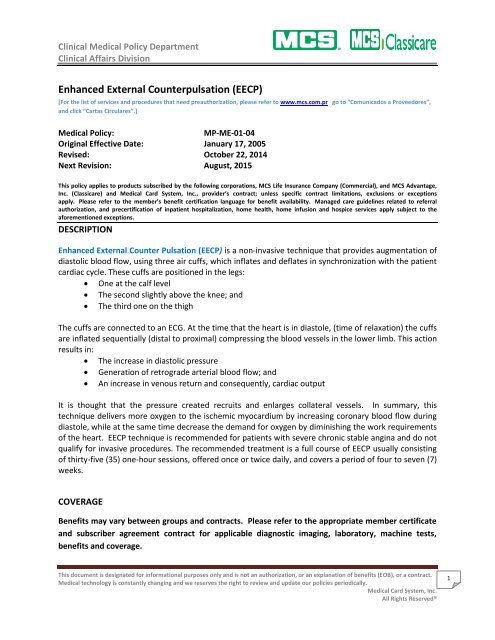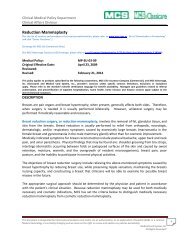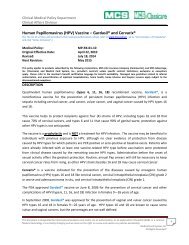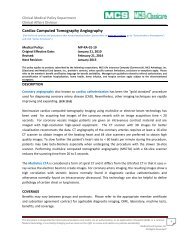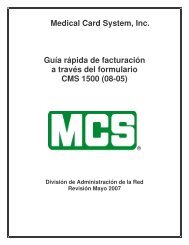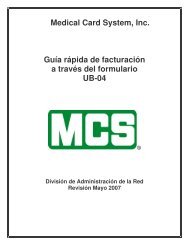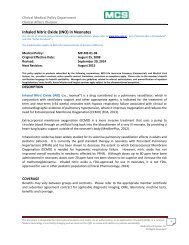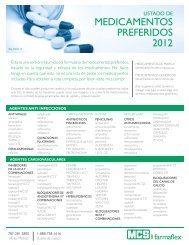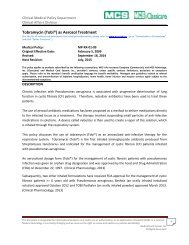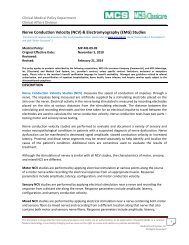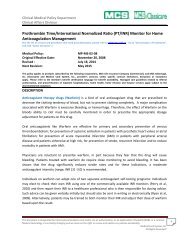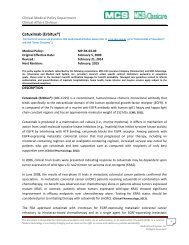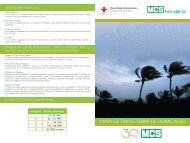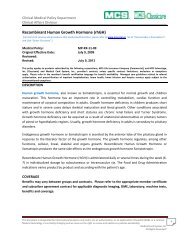Enhanced External Counterpulsation - MCS a
Enhanced External Counterpulsation - MCS a
Enhanced External Counterpulsation - MCS a
You also want an ePaper? Increase the reach of your titles
YUMPU automatically turns print PDFs into web optimized ePapers that Google loves.
Clinical Medical Policy Department<br />
Clinical Affairs Division<br />
<strong>Enhanced</strong> <strong>External</strong> <strong>Counterpulsation</strong> (EECP)<br />
[For the list of services and procedures that need preauthorization, please refer to www.mcs.com.pr go to “Comunicados a Proveedores”,<br />
and click “Cartas Circulares”.]<br />
Medical Policy:<br />
MP-ME-01-04<br />
Original Effective Date: January 17, 2005<br />
Revised: October 22, 2014<br />
Next Revision: August, 2015<br />
This policy applies to products subscribed by the following corporations, <strong>MCS</strong> Life Insurance Company (Commercial), and <strong>MCS</strong> Advantage,<br />
Inc. (Classicare) and Medical Card System, Inc., provider’s contract; unless specific contract limitations, exclusions or exceptions<br />
apply. Please refer to the member’s benefit certification language for benefit availability. Managed care guidelines related to referral<br />
authorization, and precertification of inpatient hospitalization, home health, home infusion and hospice services apply subject to the<br />
aforementioned exceptions.<br />
DESCRIPTION<br />
<strong>Enhanced</strong> <strong>External</strong> Counter Pulsation (EECP) is a non-invasive technique that provides augmentation of<br />
diastolic blood flow, using three air cuffs, which inflates and deflates in synchronization with the patient<br />
cardiac cycle. These cuffs are positioned in the legs:<br />
One at the calf level<br />
The second slightly above the knee; and<br />
The third one on the thigh<br />
The cuffs are connected to an ECG. At the time that the heart is in diastole, (time of relaxation) the cuffs<br />
are inflated sequentially (distal to proximal) compressing the blood vessels in the lower limb. This action<br />
results in:<br />
The increase in diastolic pressure<br />
Generation of retrograde arterial blood flow; and<br />
An increase in venous return and consequently, cardiac output<br />
It is thought that the pressure created recruits and enlarges collateral vessels. In summary, this<br />
technique delivers more oxygen to the ischemic myocardium by increasing coronary blood flow during<br />
diastole, while at the same time decrease the demand for oxygen by diminishing the work requirements<br />
of the heart. EECP technique is recommended for patients with severe chronic stable angina and do not<br />
qualify for invasive procedures. The recommended treatment is a full course of EECP usually consisting<br />
of thirty-five (35) one-hour sessions, offered once or twice daily, and covers a period of four to seven (7)<br />
weeks.<br />
COVERAGE<br />
Benefits may vary between groups and contracts. Please refer to the appropriate member certificate<br />
and subscriber agreement contract for applicable diagnostic imaging, laboratory, machine tests,<br />
benefits and coverage.<br />
This document is designated for informational purposes only and is not an authorization, or an explanation of benefits (EOB), or a contract.<br />
Medical technology is constantly changing and we reserves the right to review and update our policies periodically.<br />
Medical Card System, Inc.<br />
All Rights Reserved®<br />
1
Clinical Medical Policy Department<br />
Clinical Affairs Division<br />
INDICATIONS<br />
Medical Card System, Inc., (<strong>MCS</strong>) will consider <strong>Enhanced</strong> <strong>External</strong> <strong>Counterpulsation</strong> (EECP) medically<br />
necessary for patients with disabling angina that meet all of the following criteria:<br />
1. Patients who have been diagnosed with disabling angina (Class III or Class IV, New York Heart<br />
Association Functional Classification or equivalent classification-see appendix) who in the<br />
opinion of a cardiologist or cardiothoracic surgeon, are NOT readily amenable to surgical<br />
intervention such as Percutaneous Transluminal Coronary Angioplasty (PTCA) or cardiac bypass,<br />
because:<br />
a. Their condition is inoperable, or at high risk of operative complications or postoperative<br />
failure;<br />
b. Their coronary anatomy is not readily amenable to such procedures; or<br />
c. They have co-morbid states that create excessive risk<br />
2. Coverage beyond a full course of thirty-five (35) one-hour sessions should be rare. Patients are<br />
re-evaluated and if there is no angina class improvement after an initial thirty-five (35) hours of<br />
treatment, up to ten additional hours of treatment may be covered up until they improve by at<br />
least one angina class.<br />
3. Re-treatment may be considered medically necessary by <strong>MCS</strong> after one year of completion of<br />
the initial full course of thirty five (35) hours of EECP, and the patient meets initial criteria and<br />
medical necessity for EECP.<br />
CONTRAINDICATIONS<br />
1. Cardiac catheterization within 2 weeks (may cause bleeding at the femoral puncture site); or<br />
2. Arrhythmias such as atrial fibrillation, atrial flutter, ventricular tachycardia, and frequent<br />
premature ventricular beats (might interfere with the device’s triggering mechanism);<br />
3. Severe peripheral vascular disease and/or phlebitis (increased risk of thromboembolus); or<br />
4. Deep vein thrombosis, and stasis ulcers; or<br />
5. Bleeding diatheses, Coumadin (warfarin) therapy with PT greater than 15 seconds and/or INR<br />
greater than 2.0 (cuffs could cause bleeding in legs); or<br />
6. Pregnant women and women of childbearing potential who do not employ a reliable<br />
contraceptive method (possible danger to the fetus).<br />
7. Significant aortic insufficiency where regurgitation would prevent diastolic augmentation<br />
This document is designated for informational purposes only and is not an authorization, or an explanation of benefits (EOB), or a contract.<br />
Medical technology is constantly changing and we reserves the right to review and update our policies periodically.<br />
Medical Card System, Inc.<br />
All Rights Reserved®<br />
2
Clinical Medical Policy Department<br />
Clinical Affairs Division<br />
PRECAUTIONS<br />
LIMITATIONS<br />
1. Severe hypertension, greater than 180/110 mmHg, (treatment could produce diastolic blood<br />
pressure above acceptable limits).<br />
2. Heart rate more than 120 bpm should be controlled prior to treatment with enhanced<br />
external counterpulsation.<br />
3. Patients at high risk of complications from increased venous return should be carefully<br />
chosen and monitored during treatment with enhanced external counterpulsation.<br />
Decreasing cardiac afterload by optimizing cuff inflation and deflation timing may help<br />
minimize increased cardiac filling pressures and the possibility of pulmonary congestion due<br />
to increased venous return.<br />
4. Patients with clinically significant valvular disease should be carefully chosen and monitored<br />
during treatment with enhanced external counterpulsation. Certain valve conditions, such<br />
as significant aortic insufficiency or severe mitral or aortic stenosis, may prevent the patient<br />
from obtaining benefit from diastolic augmentation and reduced cardiac afterload in the<br />
presence of increased venous return.<br />
1. EECP is considered investigational for any condition not listed above, including, but not<br />
limited to congestive heart failure, acute myocardial infarction and cardiogenic shock<br />
because there is inadequate scientific evidence to permit conclusions about the efficacy of<br />
this treatment for conditions other than disabling angina as specified in the covered services<br />
section above.<br />
2. Patient could be re-evaluated and if there is not angina class improvement after the initial<br />
thirty five (35) hours of treatment, a limit of ten additional hours of treatment may be<br />
covered until they improve by at least one angina class. .<br />
3. Procedure must be performed under direct supervision of a physician. The physician must<br />
be present in the office suite and immediately available to provide assistance and direction<br />
throughout the time the personnel is performing the service.<br />
4. The use of hydraulic versions of these treatment devices is NON-COVERED, and therefore<br />
will be denied.<br />
This document is designated for informational purposes only and is not an authorization, or an explanation of benefits (EOB), or a contract.<br />
Medical technology is constantly changing and we reserves the right to review and update our policies periodically.<br />
Medical Card System, Inc.<br />
All Rights Reserved®<br />
3
Clinical Medical Policy Department<br />
Clinical Affairs Division<br />
CODING INFORMATION<br />
HCPCS® CODES (LIST MAY NOT BE ALL INCLUSIVE)<br />
HCPCS CODES<br />
G0166<br />
DESCRIPTION<br />
<strong>External</strong> <strong>Counterpulsation</strong>, Per Treatment Session<br />
2014 HCPCS LEVEL II Professional Edition® (American Medical Association).<br />
ICD-9 CM® DIAGNOSIS CODES (LIST MAY NOT BE ALL INCLUSIVE)<br />
ICD-9 CM®<br />
DESCRIPTION<br />
CODES<br />
413.9 Other and unspecified angina pectoris<br />
2014 ICD-9-CM® For Physicians, VOLUMES I & II, Professional Edition (American Medical Association).<br />
ICD-10 Codes (Preview Draft)<br />
In preparation for changes in the coding systems form ICD- 9 to ICD -10, this policy includes a sample list<br />
of ICD-10 codes for your reference. These codes may become subject to changes or modifications since<br />
they will be in effect on October 1, 2015.<br />
ICD 10 CODES<br />
I20.8 Other forms of angina pectoris<br />
I20.9 Angina pectoris, unspecified<br />
DESCRIPTION<br />
REFERENCES<br />
1. Aarush Manchanda, MD, and Ozlem Soran, MD, MPH, FACC, FESC. (2007). <strong>Enhanced</strong> <strong>External</strong><br />
<strong>Counterpulsation</strong> and Future Directions Step Beyond Medical Management for Patients with<br />
Angina and Heart Failure. J Am Coll Cardiol. 50 (16), 1523-1531. Accessed on August 20, 2014.<br />
Available at URL address: http://content.onlinejacc.org/article.aspxarticleid=1138569<br />
2. Centers for Medicare & Medicaid Services (CMS), First Coast Service Options, Inc. LCD for<br />
<strong>External</strong> <strong>Counterpulsation</strong> (ECP) (L29322). For services performed on or after 3/2/2009.<br />
Accessed on August 20, 2014. Available at URL address: http://www.cms.gov/medicarecoverage-database/details/lcddetails.aspxLCDId=29322&ContrId=371&ver=4&ContrVer=1&CntrctrSelected=198*1&Cntrctr=1<br />
98&name=First+Coast+Service+Options%2c+Inc.+(09202%2c+MAC+-<br />
+Part+B)&s=46&bc=AggAAAIACAAAAA%3d%3d&<br />
3. Center for Medicare & Medicaid Services (CMS). <strong>External</strong> counterpulsation therapy. Medicare<br />
Coverage Issues Manual Section 35-74, Issue #CAG-00003. Accessed on August 20, 2014.<br />
Available at URL address: http://www.dmerc.com/manual/medical%20procedures.htm#_1_80<br />
This document is designated for informational purposes only and is not an authorization, or an explanation of benefits (EOB), or a contract.<br />
Medical technology is constantly changing and we reserves the right to review and update our policies periodically.<br />
Medical Card System, Inc.<br />
All Rights Reserved®<br />
4
Clinical Medical Policy Department<br />
Clinical Affairs Division<br />
4. Centers for Medicare & Medicaid (CMS), National Coverage Determinations, Manual System<br />
Chapter 1. Rev. 171, 07-18-14. Section 20.20. Accessed on August 20, 2014. Available at URL<br />
address: https://www.cms.gov/manuals/downloads/ncd103c1_Part1.pdf<br />
5. Centers for Medicare & Medicaid Services (CMS), Medicare Claims Processing Manual.<br />
Transmittal 898. Pub. 100-04. <strong>External</strong> <strong>Counterpulsation</strong> Therapy (ECP). Date: March 31, 2006.<br />
Accessed on August 20, 2014. Available at URL address: http://www.cms.gov/Regulations-and-<br />
Guidance/Guidance/Transmittals/downloads/R898CP.pdf<br />
6. Goldman, L., Hashimoto, B., Cook, E.F., (1981). Comparative reproducibility and validity of<br />
systems for assessing cardiovascular functional class: Advantages of a new specific activity scale.<br />
Circulation, 64 (6). 1227-1264. Accessed on August 20, 2014. Available at URL address:<br />
http://circ.ahajournals.org/content/64/6/1227.long<br />
7. Sayami, L.A., Ullah, M., Rahman M.T., Rahman, Z., Roy, D., Majumder, A.AS. (2010). <strong>Enhanced</strong><br />
<strong>External</strong> <strong>Counterpulsation</strong> A Review. Cardiovascular. J. 2 (2): 236-244. Searched on August 20,<br />
2014. Accessed on August 20, 2014. Available at URL:<br />
http://www.banglajol.info/bd/index.php/CARDIO/article/viewFile/6647/5111<br />
8. Sinvhal, R. M., Gowda R. M., Khan, I. A., (2003). <strong>Enhanced</strong> external counterpulsation for<br />
refractory angina pectoris. Heart, (89), 830–833. Accessed on August 21, 2014. Available at URL<br />
Address: http://www.ncbi.nlm.nih.gov/pmc/articles/PMC1767754/pdf/hrt08900830.pdf<br />
9. Vasomedical Inc. (2004). The Physician’s Guide to EECP therapy. Accessed on August 20, 2014.<br />
Available at URL address: http://lifelineheart.com/PDF/EECP%20Presentation.pdf<br />
POLICY HISTORY<br />
DATE ACTION COMMENT<br />
January 17, 2005<br />
Origination of Policy<br />
December 18, 2007 Revised Added (Delivery of sessions within four to seven weeks for a total of 35<br />
hours of treatment versus 5 weeks.)<br />
August 11, 2009 Revised Policy revised to add a new coverage: retreatment of EECP after one year<br />
of completion of the initial full course of 35 hours of EECP.<br />
HCPC code (G0166) and ICD-9 Codes (413.0, 413.1, and 413.9) added to<br />
the policy. Contraindication #3 of policy MP-ME-01-04 of 2008 (Aortic<br />
insufficiency (regurgitation might prevent diastolic augmentation) was<br />
deleted from 2009 policy. Contraindication #4 of policy MP-ME-01-04 of<br />
2008 policy the word “Severe” was added to peripheral<br />
vascular disease to read, Severe vascular disease and/or phlebitis<br />
(increased risk of thromboembolus) for 2009 policy. Contraindication #5<br />
of policy MP-ME-01-04 of 2008 the word “varicosities” was deleted to<br />
read, Deep vein thrombosis and stasis ulcers for 2009 policy.<br />
August 24, 2010 Revised Deleted ICD-9 Codes 413.0, 413.1<br />
The following limitations were added to the policy:<br />
1. Coverage beyond a full course of thirty-five (35) one-hour sessions<br />
should be rare. Members are re-evaluated and if there is no angina<br />
class improvement after an initial thirty-five (35) hours of treatment,<br />
up to ten additional hours of treatment may be covered up until they<br />
improve by a least one angina class.<br />
This document is designated for informational purposes only and is not an authorization, or an explanation of benefits (EOB), or a contract.<br />
Medical technology is constantly changing and we reserves the right to review and update our policies periodically.<br />
Medical Card System, Inc.<br />
All Rights Reserved®<br />
5
Clinical Medical Policy Department<br />
Clinical Affairs Division<br />
2. Procedure must be performed under direct supervision of a physician.<br />
The physician must be present in the office suite and immediately<br />
available to provide assistance and direction throughout the time the<br />
personnel is performing the service.<br />
3. The use of hydraulic versions of these treatment devices is NON-<br />
COVERED, and therefore will be denied<br />
August 25, 2011 Revised Added Precautions<br />
August 10, 2012 Yearly Review References updated.<br />
December 10, 2012 Reviewed Policy was reviewed and approved by the Medical Card System (<strong>MCS</strong>)<br />
Medical Advisory Committee (MAC) on December 10, 2012.<br />
August 20, 2013 Yearly Review 1. References updated – (#1, #6 and #7 were added to the Medical<br />
Policy).<br />
2. Contraindication #7 was added to the Medical Policy.<br />
3. Precautions #3 and #4 were added to the Medical Policy.<br />
February 21,2014 Revised To the Coding section: A new ICD-10 Codes (Preview Draft) section was<br />
added to the policy.<br />
August 21, 2014 Yearly Review 1. References updated.<br />
2. To the Limitations section:<br />
‣ Limitations #2 was eliminated and was maintained in the<br />
Indications section according to the LCD (L29322).<br />
3. Reference #8 was added to Policy.<br />
Appendix<br />
New York Heart Association Functional Classification of Cardiac Disability<br />
Class I: Patients with cardiac disease but without resulting limitations of physical activity. Ordinary physical activity<br />
does not cause undue fatigue, palpitation, dyspnea, or anginal pain.<br />
Class II: Patients with cardiac disease resulting in slight limitation of physical activity. They are comfortable at rest.<br />
Ordinary physical activity results in fatigue, palpitation, dyspnea, or anginal pain.<br />
Class III: Patients with cardiac disease resulting in marked limitation of physical activity. They are comfortable at<br />
rest. Less than ordinary physical activity causes fatigue, palpitation, dyspnea, or anginal pain.<br />
Class IV: Patients with cardiac disease resulting in inability to carry on any physical activity without discomfort.<br />
Symptoms of cardiac insufficiency or of the anginal syndrome may be present even at rest. If any physical activity is<br />
undertaken, discomfort is increased.<br />
Source: Adapted from Goldman et al (1981)<br />
This document is for informational purposes only. It is not an authorization, certification, explanation of benefits, or contract. Receipt of<br />
benefits is subject to satisfaction of all terms and conditions of coverage. Eligibility and benefit coverage are determined in accordance with<br />
the terms of the member’s plan in effect as of the date services are rendered. Medical Card System, Inc., (<strong>MCS</strong>) medical policies are<br />
developed with the assistance of medical professionals and are based upon a review of published and unpublished information including, but<br />
not limited to, current medical literature, guidelines published by public health and health research agencies, and community medical<br />
practices in the treatment and diagnosis of disease. Because medical practice, information, and technology are constantly changing, Medical<br />
Card System, Inc., (<strong>MCS</strong>) reserves the right to review and update its medical policies at its discretion. Medical Card System, Inc., (<strong>MCS</strong>)<br />
medical policies are intended to serve as a resource to the plan. They are not intended to limit the plan’s ability to interpret plan language as<br />
deemed appropriate. Physicians and other providers are solely responsible for all aspects of medical care and treatment, including the type,<br />
quality, and levels of care and treatment they choose to provide.<br />
This document is designated for informational purposes only and is not an authorization, or an explanation of benefits (EOB), or a contract.<br />
Medical technology is constantly changing and we reserves the right to review and update our policies periodically.<br />
Medical Card System, Inc.<br />
All Rights Reserved®<br />
6


